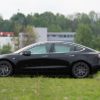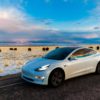
It seems that everyone these days is talking about the fastest electric car. Some experts predict that within ten years, electric performance cars will be as common and normal as their gasoline-powered counterparts. Even those who doubt this theory are beginning to look ahead to a time when all motor vehicles are completely powered by electricity. Although some of these models have been highly exclusive or rather expensive and only available on the rarest of occasions, the ideas and technology behind them is believed to very quickly trickle down to more affordable and general-use electric performance cars over the next few years.
The Porsche Cayman –
The Porsche Cayman isn’t the only fast vehicle out there. For years, the Toyota Prius has held the title of world’s fastest electric car. Now, the company plans to build an even cheaper version of the Prius. If it can get a gas mileage that close to those of the Porsche, it can hardly be called a scaled-down model. The engineers at Toyota have already perfected the internal combustion engine, and they plan to make it simpler and cheaper to produce. Soon, Prius owners everywhere will be able to enjoy the same zero-emission power that’s responsible for the car’s incredible fuel efficiency.
Drive At The Same Speed As A Ferrari And A Lamborghini
If it’s possible for a car to drive at the same speed as a Ferrari and a Lamborghini, then why can’t it drive at the same speed as a Mercedes-Benz? That’s what the engineers at DAF also believe, and they believe it’s possible within the next few years. The new system will allow the car to reach the speed of around sixty times the speed of sound. This might sound like a ridiculous figure, but it really does represent a major leap forward for automotive technology.
There’s another reason why the new system may be capable of reaching the speed of a Lamborghini and a Ferrari at the same time. Since both cars use their own separate electric motors to generate all of their power, they must use different systems if they want to reach the same top speed. If a Lamborghini utilizes a smaller electric motor to generate its power, then it must use a shorter system than a Ferrari, which must use a longer wheelbase to generate the same torque as a Lamborghini. So now, for cars with similar overall dimensions, there could only be one car that could truly claim to be the fastest electric car.
Long Range Electric Sports Car
How about a long range electric sports car? It would require something completely different than a typical electric car. For one thing, it would need a series of batteries, and those batteries would have to be strong and deep penetrating to support the high levels of torque offered by its electric motor. Batteries are expensive, and if they were to break, you’d be stuck with nothing but a scrap vehicle.
However, what if we took out the batteries altogether? In order for an electric car to really reach its maximum top speed, it would need to use a battery that was capable of sustaining high levels of voltage throughout its life. In order to do this, we’d have to use a series of lead acid flooded batteries, which would allow us to attain an incredible sixty-two miles per hour (mph). Not only would this be the fastest electric car, it would also be the most impractical, as it would be difficult to justify having to carry such a large amount of weight and batteries around in order to reach sixty miles per hour.
Final Words
The key to achieving this feat would be a small and efficient high voltage inverter. By using a series of high-capacity lead acid flooded batteries and a series of lead acid flooded batteries, we would allow us to achieve a lotus Evija running at a maximum of sixty miles per hour. This is actually not very far from Lamborghini’s and Ferrari’s best speeds, as well as a lotus Evija’s claimed fuel mileage. Now that we’ve got that settled, what’s stopping us from building our own electric motors and driving it around the block? If we find a lotus Evija in the Lotus Eviola test track, who knows, maybe the government will pay us for building one?





